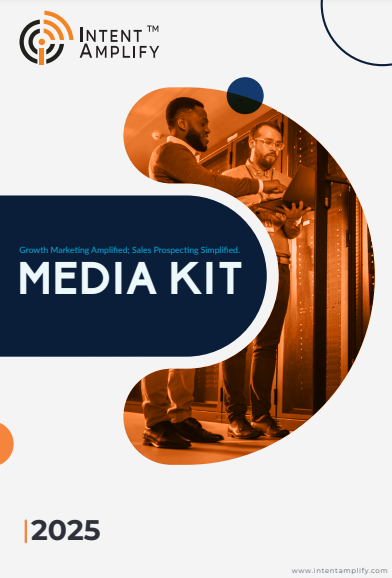
How to Syndicate Content for B2B Leads in 2025
- Last updated on: June 26, 2025
Content syndication is not only around in 2025, it’s growing as a lead-gen contender to be taken seriously. In a crowded B2B world swimming in content, syndication helps cut through the clutter by placing brands’ content in front of target buyers where they’re already engaged. Done right, syndication proves brand authority, builds qualified traffic, and lines the top of the funnel with intent-based leads. Syndicate Content for B2B Leads effectively, and you’ll not only increase reach but also drive measurable conversions across the funnel.
What’s new this year? AI personalization has gone mainstream on every major syndication platform. From real-time topic association to dynamic content placement by firmographics and buyer stage, syndication of content now yields more than impressions; it yields results. It’s also being used not just for awareness, but to accelerate mid-funnel nurturing in ABM programs.
The advent of pay-for-performance models has altered budget planning. Instead of buying eyeballs, B2B marketers buy outcomes: MQLs, form submissions, or engagement. Add the power of smart platforms like Intent Amplify, and it’s clear syndication has grown up. Yet syndication is not a universal game. The result hinges on the harmony of your content, audience, and channel. This guide analyzes how to syndicate content for maximum B2B lead generation in 2025 strategically, scalably, and smartly.
Mapping Content to Funnel Stage: Don’t Just Publish, Plan
Effective syndication starts with clarity about what content is in what place. Not every whitepaper or webinar deserves mass mailing. To convert attention into leads, your asset needs to match the funnel phase and the buyer intent profile of the channel.
For top-of-funnel (TOFU) visibility, use ungated thought leadership – articles, blog posts, and short videos. These build familiarity without resistance. Channels like LinkedIn Articles, Medium, and industry blogs shine here. Middle-of-funnel (MOFU) assets like gated whitepapers, case studies, and industry reports work better on partner sites with targeting. These would typically have lead capture forms and first-party intent signals. Bottom-of-funnel (BOFU) content like pricing sheets or product comparison tools work best in retargeted syndication or through email nurtures triggered by prior syndication engagement.
Syndicate Content for B2B Leads based on funnel alignment to ensure that each asset lands where it will do the most work, whether that’s capturing attention or converting interest. The lesson here is don’t just query where to place your content – query why now, why here, and why this asset. Align your message with buyer intent as well as the type of platform. That’s the distinction between a passive impression and a pipeline opportunity.
Selecting the Right Syndication Channels: Free, Paid, or Hybrid
In 2025, the syndication landscape is broader than ever, but not all options are equal when your goal is lead quality. Here’s how to decide where your content should live.
Free syndication channels include LinkedIn Articles, Reddit comments, Substack newsletters, SlideShare presentations, and Medium blogs. They rely on community or editorial curation and not paid targeting. They deliver long-tail SEO value because republished content can outrank the original, especially when published on high-authority domains. Free channels are best for TOFU brand awareness and thought leadership positioning.
Paid syndication portals, including Intent Amplify, INFUSE Media, and NetLine, provide more targeted piercing, data association, and pay-per-lead costs. They enable you to target company size, industry, job title, and even install base or intent score. They work best for MOFU and BOFU engagement where the goal is MQL volume, sales handoffs, or pipeline contribution.
Hybrid strategies combine both. So, a report might be ungated and published on LinkedIn for organic visibility and also syndicated through Intent Amplify for ABM targeting. The secret is knowing what you get with each channel: free gets you SEO and brand equity, paid gets you velocity and precision. The smart play in 2025? Syndicate like a portfolio—some channels create, others convert.
Best Syndication Platforms That Deliver in 2025
With B2B budgets under pressure to prove ROI, choosing a platform is now a strategic necessity. Below are the five top syndication platforms of 2025, each offering something new for lead generation.
1. Intent Amplify
Intent Amplify is an intent-powered, full-funnel syndication engine. It’s meant for B2B marketers who require reach and relevance. It uses AI to match content to in-market accounts, deploying assets to decision-makers through behavioral signals. The closed-loop feedback is what ties it together: marketers can see which accounts engaged, what they clicked, and where they’re in the purchase process. This tightens integration with sales and marketing automation platforms. Intent Amplify is ideal for ABM programs that need to scale high-intent MQLs without wasting impressions.
2. INFUSE Media
Known for its lead guarantee and compliance-first strategy, INFUSE Media provides global reach with quality front and center. Its double-opt-in confirmation process ensures that leads are true, verified, and responsive. It’s particularly popular among technology marketers promoting industry reports or webinars who want clean, sales-ready data. In 2025, INFUSE has also added more sophisticated personalization with its persona-based targeting engine, allowing marketers to avoid “spray-and-pray” content distribution.
3. NetLine
NetLine remains a player in self-service syndication. It’s a do-it-yourself platform that allows marketers to launch campaigns, set CPL rates, and segment by company demographics and industry intent. It’s highly cost-effective for mid-sized brands or vertical niches. NetLine’s buyer-level intent scoring is refreshed in real time, which enables more accurate nurture flows after the lead.
4. Outbrain for B2B
While traditionally used on consumer content, Outbrain‘s business division is becoming increasingly popular for native syndication. It’s particularly well-suited to drive traffic to TOFU content like blogs or thought leadership. Using content discovery widgets on high-authority publisher domains drives volume at scale. When paired with remarketing flows, Outbrain can also be used for warming up audiences before sending them to gated offers.
5. TechTarget
TechTarget combines syndication with deep research purpose. Their Priority Engine reveals live buyer behavior, while their content network distributes gated assets to extremely qualified leads. It’s a favorite among mid to enterprise-level cybersecurity and SaaS marketers. TechTarget also expanded its regional penetration in 2025, which makes it ideal for global campaigns.
All these platforms have varying strengths—use them based on your goal: scale, quality, targeting, or conversion.
Measuring Success: Metrics That Matter More Than Clicks
In 2025, smart syndication measurement goes way beyond CTRs or opens to lead quality, depth of engagement, and influence on revenue. Start with lead qualification. Are contacts conforming to your ICP? Review company size, industry, job title, and intent data. Don’t just track form fills—look at lead velocity, opportunity conversion, and sales feedback.
Next, measure content performance by platform. What asset is producing the highest engagement-to-lead ratio? Which channels generate the highest SALs? Attribution modeling software can help here, especially multi-touch models attributing content to backing deals, not originating them.
Finally, monitor pipeline impact. Ask: What was the cost per qualified lead? How many MQLs led to closed-won deals? What platforms generate the most opportunities? These are questions that link syndication to revenue, enabling smarter investment in the future. In order to grow effectively, map marketing KPIs to business outcomes, not only platform metrics.
Syndication + ABM: A Perfect Match in 2025
Account-based marketing (ABM) and content syndication are no longer segregated processes—they’re closely intertwined in 2025. Intent Amplify platforms have unified intent signals, account scoring, and syndication flows together, and as a result, content now finds itself in front of the right individuals at the right time.
Here’s how it all works: Your tiered target accounts are identified by your ABM team. You allocate assets—use cases, product descriptions, reports—to each tier. Syndication partners deliver this content directly to decision-makers within those accounts. When a target account from one of your target companies engages, your sales team receives a real-time notification to launch a contextual outreach.
This approach does not just increase reach but also relevance. Instead of blanket campaigns, you’re now delivering account-specific value that hits with precision. Post-engagement, retargeting, and email nurturing can then further build the relationship up until a sales conversation is timely. Syndication combined with ABM thinking takes what was once passive content distribution and makes it an active pipeline acceleration engine.
Syndicate with Purpose, Not Just Reach
Content syndication in 2025 is not about being everywhere—it’s about being where it matters. From AI-matched targeting to performance-driven budgeting, the trend is evident: effectiveness is now based on strategy, not quantity.
Whether you use free sites for awareness of your brand or paid options for quality leads, the secret is alignment. Align content to the buyer process. Align sites to objectives. And most importantly, align measurement to business outcomes, not vanity metrics.
If you’re looking to scale your B2B lead generation engine this year, syndication remains one of the most effective and underutilized tools, especially when paired with ABM and intent data.
In the hands of a focused marketer, it’s not just content distribution. It’s content with direction.
FAQs
Q1: What’s the best type of content for syndication in 2025?
Whitepapers, case studies, and industry reports work best in lead capture, while blogs and thought leadership work best in brand awareness on free platforms.
Q2: Does syndicated content harm my SEO?
Not if implemented correctly. Utilize canonical tags and make your content always available first on your site before syndicating. A few sites even provide do-follow backlinks.
Q3: How do I track ROI from syndicated leads?
Utilize UTM parameters, marketing automation tools, and CRM integration to track lead quality, funnel velocity, and closed-won attribution.
Q4: What is the time frame to realize content syndication results?
Paid campaigns can produce leads in a matter of days. Organic/free syndication can take weeks but creates long-term value.
Q5: What is a good CPL for B2B syndication?
It varies based on the industry and role, but for experienced SaaS or tech leads, $60–$150 per lead is average in 2025.




